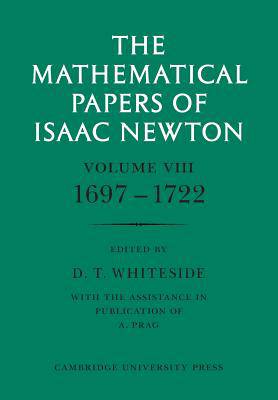
Door een staking bij bpost kan je online bestelling op dit moment iets langer onderweg zijn dan voorzien. Dringend iets nodig? Onze winkels ontvangen jou met open armen!
- Afhalen na 1 uur in een winkel met voorraad
- Gratis thuislevering in België vanaf € 30
- Ruim aanbod met 7 miljoen producten
Door een staking bij bpost kan je online bestelling op dit moment iets langer onderweg zijn dan voorzien. Dringend iets nodig? Onze winkels ontvangen jou met open armen!
- Afhalen na 1 uur in een winkel met voorraad
- Gratis thuislevering in België vanaf € 30
- Ruim aanbod met 7 miljoen producten
Zoeken
Omschrijving
When Newton left Cambridge in April 1696 to take up, at the age of 53, a new career at the London Mint, he did not entirely 'leave off Mathematicks' as he so often publicly declared. This last volume of his mathematical papers presents the extant record of the investigations which for one reason and another he pursued during the last quarter of his life. In January 1697 Newton was tempted to respond to two challenges issued by Johann Bernoulli to the international community of mathematicians, one the celebrated problem of identifying the brachistochrone; both he resolved within the space of an evening, producing an elegant construction of the cycloid which he identified to be the curve of fall in least time. In the autumn of 1703, the appearance of work on 'inverse fluxions' by George Cheyne similarly provoked him to prepare his own ten-year-old treatise De Quadratura Curvarum for publication, and more importantly to write a long introduction to it where he set down what became his best-known statement of the nature and purpose of his fluxional calculus.
Specificaties
Betrokkenen
- Auteur(s):
- Uitgeverij:
Inhoud
- Aantal bladzijden:
- 772
- Taal:
- Engels
- Reeks:
Eigenschappen
- Productcode (EAN):
- 9780521045919
- Verschijningsdatum:
- 11/02/2008
- Uitvoering:
- Paperback
- Formaat:
- Trade paperback (VS)
- Afmetingen:
- 170 mm x 244 mm
- Gewicht:
- 1206 g

Alleen bij Standaard Boekhandel
+ 225 punten op je klantenkaart van Standaard Boekhandel
Beoordelingen
We publiceren alleen reviews die voldoen aan de voorwaarden voor reviews. Bekijk onze voorwaarden voor reviews.











